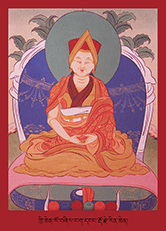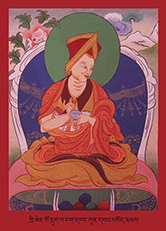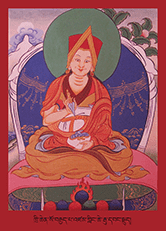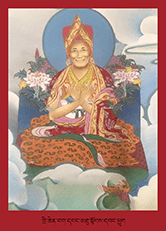The following is taken from a letter Rinpoche wrote to his younger brother about
their family history.
Our great-grandfather Ngawang Thutob Wangchug was the 40th Throne Holder of Sakya. He was born into the
Phuntsok Phodrang in 1900 in Palden Sakya. His noble father was the 38th Throne Holder, Dzamling Chegu Wangdu
Nyingpo (1855-1919). His mother was from the aristocratic dynasty of Thunmi Sambhota (the progenitor of the
Tibetan script long ago); her name was Chonyi Wangmo.
His mother experienced no discomfort giving birth to him and people beheld many wondrous signs of
auspiciousness when he was born. His noble father was the one who named him and his full name was Ngawang Thutob
Wangchug Dragshul Yonten Gyatso Tashi Dragpai Gyaltsen Pal Zangpo.
He was an expert in the meaning of the Tripitaka and four classes of
It is said in many hidden termas by Guru Padmasambhava that in his previous lives Ngawang Thutob Wangchug was:
Acarya Manjusrimitra (of the eight great Vidyadharas, he was the progenitor of the Yamantaka teachings), the
great Pandit Vimalamitra (who caused the Dzogchen teachings to flourish in Tibet), the mighty Dharma King
Trisong Detsen, Ngadag Nyangral, Guru Chöwang and other Tertöns in twelve successive incarnations. The
thirteenth of these was Jamyang Khyentse Wangpo (1820-1892).
He was also the Mahasiddha Ghantapada (a great yogi of the Cakrasamvara teachings), Vanaratna (a master of the
Kalacakra Tantra), Pandit Pratiharanandamati, Drom Tonpa (who founded the Kadam tradition of Atisha in Tibet),
the great Jetsun Dragpa Gyaltsen (one of the most important founding masters of the Sakyapa), the matchless
Dagpo Lhaje (a.k.a. Gampopa, the founding father of the main Kagyu traditions), Longchen Rabjampa (one of the
greatest masters of the Nyingma tradition), Thangtong Gyalpo (the renowned Mahasiddha mainly associated with the
Shangpa lineage), the first Dalai Lama Gedun Drub, as well as Lhatsun Namkha Jigme and other great scholars and
practitioners without any sectarian biases. He also reincarnated as the abbot of the main Ngor Monastery,
Thartse Namkha Chime, and then as "the one who possesses the seven amazing teaching transmissions" – that is
Jamyang Khyentse Wangpo.
While still in this world, Jamyang Khyentse Wangpo gathered his emanations into the heart of Vimalamitra in the
Five Peaks in China, which are the sacred mountains like Wu Ta'i Shan. He really wanted to help sentient beings,
so he then emanated in five incarnations. One of those emanations was Ngawang Thutob Wangchug, as was directly
foretold in terma-prophecies and attested to by the great Jamgon Kongtrul Lodro Thaye (1813-1899), Dodrubchen
Tenpai Nyima (1865-1926) and so on. The five emanations were of body, speech, mind, qualities and activities. Of
these, he came to be known as the emanation of the qualities of Jamyang Khyentse Wangpo.
From the tender age of six, he began to master the Buddhist teachings without great hardship – he could even
control the mamos, the fierce female spirits that could perhaps be compared to harpies in Western
folklore. Under the tutelage of Ponlob Dragpa Namgyal, he mastered all the ritual practices of the main Sakya
Monastery, as well as the cham Lama-dances, ritual-music, melodic chants, line-marking of mandalas
and all the other such specialist Buddhist practices, and all of them he mastered with extraordinary ease and
perfection, so his vision and knowledge increased a great deal.
As he grew up, his teachers were his noble father, Dzamling Chegu Wangdu, as well as the great 39th Sakya
Throne Holder, Dragshul Thrinle Rinchen (from whom he received the Lam-dre); also Khangsar Khenchen
Zhenphen Nyingpo; Khyabgön Jamyang Thubten Zangpo; Ngor Luding Gyalse Chökyi Nyima, and many other amazing
masters. He received all the precious teachings of Sakya from them as well as the vast ocean of sacred teachings
of the Old and New Translation Movements that flourished in Tibet.
After studying at their lotus-feet, then contemplating and mastering these holy instructions, it was just like
water from one jewelled vase being poured into another jewelled vase, without any sectarian biases or errors.
Through abandoning what needs to abandoned and perfecting his meditation, he attained the actual results of his
practice on the basis of the authentic Dharma.
He was able to train his own mind because he undertook intensive retreats. He undertook the Vajrayana retreats
of Vajrapani Bhutadamara, Hevajra, Vajrakila, Mahakala Panjaranatha, Mahakala Caturmukha and many others. He
completed them all properly with fire-pujas and continued through his life to cultivate the meditation of the
two stages, which are the stages of generation and completion of Vajrayana practice.
In 1937, he was majestically enthroned on an astrologically virtuous day in a great celebration with a huge
assembly at the main Northern Monastery of Sakya as Throne Holder, which he held until he passed into
parinirvana.
So by then, since he had received so many precious teachings, empowerments, aural transmissions,
pith-instructions, guiding instructions and so forth from his precious masters, then he became the greatest
master for giving these teachings himself, and gave them tirelessly to unfathomable gatherings of disciples.
They didn't just sit and listen to the teachings like casual spectators, but were matured, ripened and placed in
liberation through his guidance.
One sign that showed his inner realization was that when he bestowed the blessing-initiation of the Vajrayogini
to Dhiphu Choje Tulku from Amdo, that Tulku experienced the actual "descent of primordial wisdom", which means
that just from receiving the blessing from Ngawang Thutob Wangchug, he attained an extraordinary inner
experience. When that happened, the Tulku levitated about fifteen inches from his cushion, remaining in
levitation for a long time and his seat shook vigorously below him as a result. Word about this spread and the
fame of Ngawang Thutob Wangchug's power as a master became legendary.
Also, when he conferred the major empowering consecration of Hevajra according to the Lam-dre to the
great abbot Ngaggi Wangchug of Tanag Monastery, the abbot gained the power of connate primordial wisdom.
He once went to Ganden Phodrang at the request of Tagdrak Rinpoche and attended a conference on problems that
were occurring. The retired regent Reting Rinpoche wanted to resume his tenure and some had sided with him in an
armed rebellion. So in order to purify this so that peace would prevail, Ngawang Thutob Wangchug conducted
ceremonies for them. During one of these practices, when he threw white mustard seeds at a torma, it produced
sounds and nectar came out of it. That evening, everyone heard a booming roar like thunder, which was the
presence of the Dharma Protectors who then caused a ritual vessel to spontaneously combust into many pieces. The
outcome was that peace did indeed prevail.
I remember one of my great-aunts told me that he once insisted that everyone in his retinue, including his
young children, participate in the full propitiation-rites of the Dharma Protectors over many days due to some
obstacles happening in Tibet. As she was quite young then and perhaps would rather be doing other things, she
thought to herself, "Oh, I wish we didn't have to do this long puja every day…" The next day, as they were
awaiting their noble father's arrival in the Protector Chapel, he stopped in his tracks, looked at her and said,
"If you don't want to practice every day, then you're not my daughter." This might sound very harsh, but since
that time, my great-aunt has practiced very diligently and it showed that he could really read minds.
During one of those pujas, as he beat the drum during part of the chanting, countless sparks of fire issued out
of the beater, and as he played the cymbals, huge flames blazed out of the cymbals, filled the room and then
gathered back into the cymbals. Many of our relatives witnessed this and then had the spontaneous faith that
this was not just their biological father but their spiritual father, their holy guru, refuge and protector.
He was once invited to the Sera monastery to conduct a fire-puja because of haunting sounds heard below the
monastery by the locals. So he travelled there, performed the puja and a huge clamour was heard in the area as
the dangerous forces were successfully driven away.
Also, when he was at Palmo Palthang, he went to a stupa on the mountain and extracted water; something
he could do because he was a Tertön. At that time, a song of yearning was sung on the circumambulation-path,
comparing him to Guru Padmasambhava:
"Great Throne Holder of the
Glorious Sakya,
You who are the real Acharya
Padma:
On the parched planes of
Palthang
You magically produced water
for us to drink."
This was a cause of further
renown.
In another instance, he was travelling westwards when an avalanche began. Since he was very powerful and
fearless, he wasn't worried but telekinetically repelled the avalanche back up the mountain.
At the main temple of Palden Sakya, he commissioned renovation work, but not in an ordinary kind of way. He did
miraculous work, like discovering hidden stone pillars, staircases and the suchlike of the finest materials.
Since he was a Tertön, he revealed a triangular treasure too, which radiated white light and thereby cast any
doubts away like rain-clouds dispersing into the sky.
When his noble father Dzamling Chegu Wangdu passed into final nirvana, Ngawang Thutob Wangchug was nowhere to
be found. This was a great cause of concern – everyone wore themselves out trying to find him. Suddenly, after
three days had passed, he appeared out of nowhere. When he was asked where he had been all that time, he replied
that he had been with his noble father and that, in fact, he had dropped him off in Sambhala, the pureland of
Kalacakra. To prove that he was telling the truth about this, he brought back a wondrous flower that no-one had
ever seen before, because it was a flower from a pureland. Everyone was stunned and it never wilted.
He helped to renovate three of the temples and one of the colleges in the south of Sakya, and attracted many
students there. Many people flocked to see him wherever he went. He expanded temples in many places. He
commissioned an inconceivable amount of representations of the body, speech and mind of our ancestors, the great
founding fathers of Sakya.
He also undertook pilgrimages, including an extensive pilgrimage to the sacred sites of the Buddha in India.
During his visit there, he met with Mahatma Ghandi. I can't remember all the details, but I remember they took a
car-ride together and naturally shared mutual respect.
In 1950, on the anniversary of Jetsun Dragpa Gyaltsen and in the very room he was born in, he passed into final
nirvana in a whirl of auspiciousness. The local officials in Sakya and other men who usually appear
rather stern were reduced to tears; even the hills crumbled down by day and by night as though the land itself
was in mourning. People witnessed the sun form a canopy in the sky that was pervaded by rainbow-clouds as
dakinis made offerings and many other inconceivable signs of wonder. During the cremation, after he had come out
of the state of thugdam (the yogic post-death meditation) and absorbed his mind into the expanse of reality, the
body was totally burnt yet the whole skull, tongue, eyes and hair of the head remained intact and an enormous
amount of relics were discovered once the fires died down.
Ngawang Thutob Wangchug left behind another special legacy in the form of his disciples, particularly his own
eminent children, the senior-most being our noble grandfather, the late Jigdal Dagchen Dorje Chang, Ngawang
Kunga Sonam (1929-2016). In fact, my noble grandfather was recognised as the reincarnation of one of Ngawang
Thutob Wangchug's own teachers, Ngor Luding Gyalse Chökyi Nyima, by Ngawang Thutob Wangchug himself.
I feel so fortunate that Ngawang Thutob Wangchug bestowed so many precious teachings on my noble grandfather,
especially the unbroken ancestral lineage of Vajrakila and the Lam-dre, and that out of his great kindness, our
noble grandfather passed those teachings onto us.
It was also so special that not only was my noble grandfather the senior-most disciple of Ngawang Thutob
Wangchug, but also of the two other most famous emanations of Jamyang Khyentse Wangpo: that is, Dzongsar Jamyang
Khyentse Chökyi Lodrö (1893-1959) and Dilgo Khyentse Rabsal Dawa (1910-1991).
The younger son of Ngawang Thutob Wangchug was our eminent great-uncle, Sakya Duldzin Ngawang Kunga Thrinle
Tashi (1934-1997). Our great-aunts, Jetsun Thubten Wangmo (1924-?), Jetsun Kelzang Chödrön (1926-2007), Jetsun
Tsejin Wangmo (b.1936), Jetsun Chime Wangmo (b.1939) and Jetsun Könchog Yangkyi (b.1944) were his daughters, and
the younger three are still with us today. Their mother – our great-grandmother, the wife of Ngawang Thutob
Wangchug – was called Mushang Jarigpa Dechen Drolma (1901-1954).
Taking his example to heart, I always think that we must aspire to follow in the footsteps of our
great-grandfather as much as we can; that we must not let our family down but strive to study and practice with
diligence, just like he did. Reflecting on his extraordinary life can inspire us as to what we can achieve
through the practice of Dharma. All of us – every sentient being – is endowed with the "Seed of the Sugata" in
our hearts, so if we practice the authentic Dharma, then we really can accomplish great realizations and benefit
many wandering beings.
All that Ngawang Thutob Wangchug did – the many miracles and so on – were from and out of bodhicitta, his
aspiration for awakening based on great compassion. The most crucial thing we must cherish in our
Dharma-practice, in our whole life in fact, is just this – bodhicitta. On this basis, I can feel confident that
if we practice in the right way, we will be able to honor the heritage of the Phuntsok Phodrang and do our very
best to help the liberating teachings of the Buddha flourish in our world.




